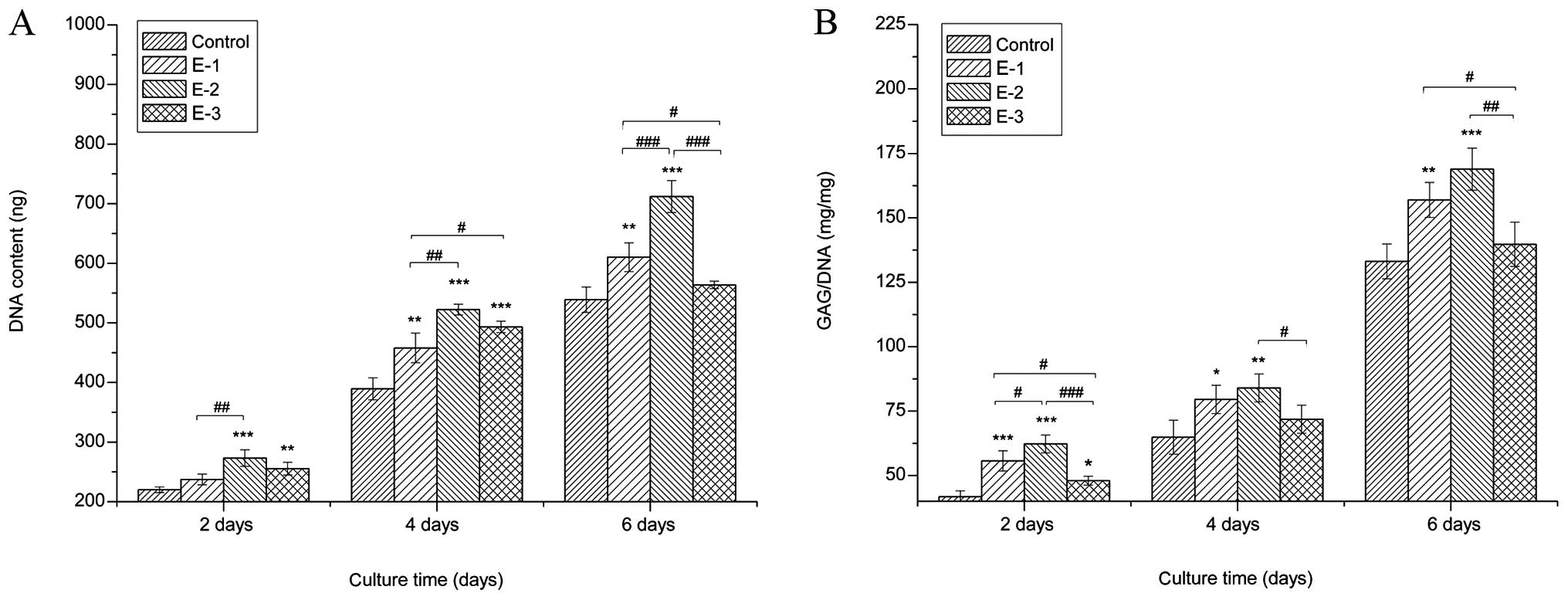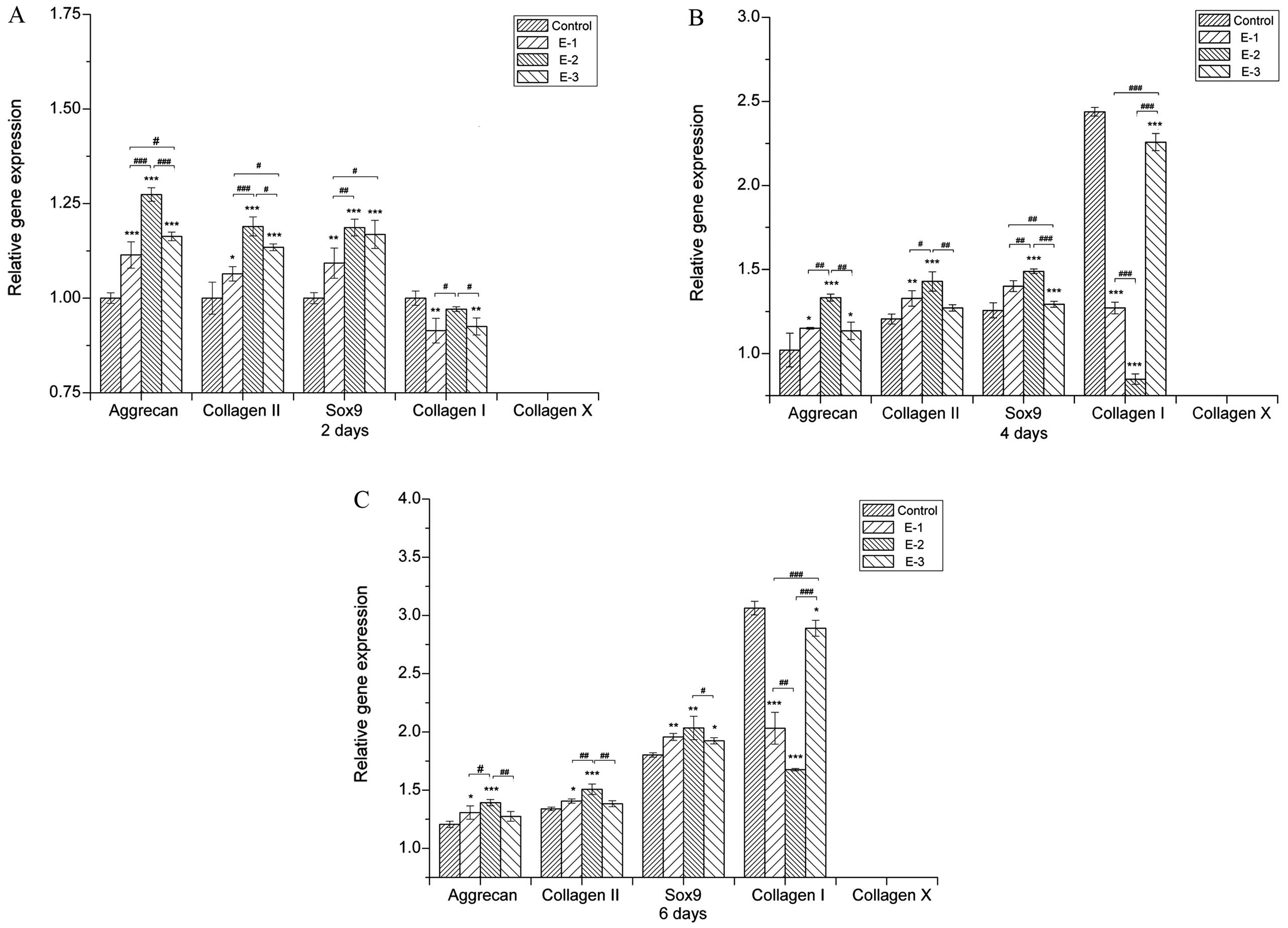|
1
|
Carranza-Bencano A, García-Paino L, Armas
Padrón JR and Cayuela Dominguez A: Neochondrogenesis in repair of
full-thickness articular cartilage defects using free autogenous
periosteal grafts in the rabbit. A follow-up in six months.
Osteoarthritis Cartilage. 8:351–358. 2000. View Article : Google Scholar : PubMed/NCBI
|
|
2
|
Sánchez M, Anitua E, Azofra J, Andía I,
Padilla S and Mujika I: Comparison of surgically repaired Achilles
tendon tears using platelet-rich fibrin matrices. Am J Sports Med.
35:245–251. 2007. View Article : Google Scholar
|
|
3
|
Chung C and Burdick JA: Engineering
cartilage tissue. Adv Drug Deliv Rev. 60:243–262. 2008. View Article : Google Scholar
|
|
4
|
Hsieh PC, Thanapipatsiri S, Anderson PC,
Wang GJ and Balian G: Repair of full-thickness cartilage defects in
rabbit knees with free periosteal graft preincubated with
transforming growth factor. Orthopedics. 26:393–402.
2003.PubMed/NCBI
|
|
5
|
Waterfield MD, Scrace GT, Whittle N, et
al: Platelet-derived growth factor is structurally related to the
putative transforming protein p28sis of simian sarcoma virus.
Nature. 304:35–39. 1983. View
Article : Google Scholar : PubMed/NCBI
|
|
6
|
Josephs SF, Guo C, Ratner L and Wong-Staal
F: Human-proto-oncogene nucleotide sequences corresponding to the
transforming region of simian sarcoma virus. Science. 223:487–491.
1984. View Article : Google Scholar : PubMed/NCBI
|
|
7
|
Downward J, Yarden Y, Mayes E, et al:
Close similarity of epidermal growth factor receptor and v-erb-B
oncogene protein sequences. Nature. 307:521–527. 1984. View Article : Google Scholar : PubMed/NCBI
|
|
8
|
del Peso L, González-García M, Page C,
Herrera R and Nuñez G: Interleukin-3-induced phosphorylation of BAD
through the protein kinase Akt. Science. 278:687–689. 1997.
View Article : Google Scholar : PubMed/NCBI
|
|
9
|
Rice-Evans CA, Miller NJ and Paganga G:
Structure-antioxidant activity relationships of flavonoids and
phenolic acids. Free Radic Biol Med. 20:933–956. 1996. View Article : Google Scholar : PubMed/NCBI
|
|
10
|
Salah N, Miller NJ, Paganga G, Tijburg L,
Bolwell GP and Rice-Evans C: Polyphenolic flavanols as scavengers
of aqueous phase radicals and as chain-breaking antioxidants. Arch
Biochem Biophys. 322:339–346. 1995. View Article : Google Scholar : PubMed/NCBI
|
|
11
|
Yang CS and Landau JM: Effects of tea
consumption on nutrition and health. J Nutr. 130:2409–2412.
2000.PubMed/NCBI
|
|
12
|
Blot WJ, McLaughlin JK and Chow WH: Cancer
rates among drinkers of black tea. Crit Rev Food Sci Nutr.
37:739–760. 1997. View Article : Google Scholar
|
|
13
|
Buschman JL: Green tea and cancer in
humans: a review of the literature. Nutr Cancer. 31:151–159. 1998.
View Article : Google Scholar
|
|
14
|
Kohlmeier L, Weterings KG, Steck S and Kok
FJ: Tea and cancer prevention: an evaluation of the epidemiologic
literature. Nutr Cancer. 27:1–13. 1997. View Article : Google Scholar : PubMed/NCBI
|
|
15
|
Na HK and Surh YJ: Intracellular signaling
network as a prime chemopreventive target of (−)-epigallocatechin
gallate. Mol Nutr Food Res. 50:152–159. 2006. View Article : Google Scholar : PubMed/NCBI
|
|
16
|
Bar-Sela G, Epelbaum R and Schaffer M:
Curcumin as an anti-cancer agent: review of the gap between basic
and clinical applications. Curr Med Chem. 17:190–197. 2010.
View Article : Google Scholar : PubMed/NCBI
|
|
17
|
Li Y, Kong D, Wang Z and Sarkar FH:
Regulation of microRNAs by natural agents: An emerging field in
chemoprevention and chemotherapy research. Pharm Res. 27:1027–1041.
2010. View Article : Google Scholar : PubMed/NCBI
|
|
18
|
Mak JC: Potential role of green tea
catechins in various disease therapies: progress and promise. Clin
Exp Pharmacol Physiol. 39:265–273. 2012. View Article : Google Scholar : PubMed/NCBI
|
|
19
|
Ahmed S: Green tea polyphenol
epigallocatechin 3-gallate in arthritis: progress and promise.
Arthritis Res Ther. 12:2082010. View
Article : Google Scholar : PubMed/NCBI
|
|
20
|
Pandey KB and Rizvi SI: Plant polyphenols
as dietary antioxidants in human health and disease. Oxid Med Cell
Longev. 2:270–278. 2009. View Article : Google Scholar
|
|
21
|
Mandel SA, Amit T, Weinreb O and Youdim
MB: Understanding the broad-spectrum neuroprotective action profile
of green tea polyphenols in aging and neurodegenerative diseases. J
Alzheimers Dis. 25:187–208. 2011.PubMed/NCBI
|
|
22
|
Stangl V, Lorenz M and Stangl K: The role
of tea and tea flavonoids in cardiovascular health. Mol Nutr Food
Res. 50:218–228. 2006. View Article : Google Scholar : PubMed/NCBI
|
|
23
|
Shanmugam MK, Kannaiyan R and Sethi G:
Targeting cell signaling and apoptotic pathways by dietary agents:
role in the prevention and treatment of cancer. Nutr Cancer.
63:161–173. 2011. View Article : Google Scholar : PubMed/NCBI
|
|
24
|
Pan MH, Lai CS, Dushenkov S and Ho CT:
Modulation of inflammatory genes by natural dietary bioactive
compounds. J Agric Food Chem. 57:4467–4477. 2009. View Article : Google Scholar : PubMed/NCBI
|
|
25
|
Bae JY, Kanamune J, Han DW, Matsumura K
and Hyon SH: Reversible regulation of cell cycle-related genes by
epigallocatechin gallate for hibernation of neonatal human tarsal
fibroblasts. Cell Transplant. 18:459–469. 2009. View Article : Google Scholar : PubMed/NCBI
|
|
26
|
Akhtar N and Haqqi TM:
Epigallocatechin-3-gallate suppresses the global
interleukin-1beta-induced inflammatory response in human
chondrocytes. Arthritis Res Ther. 13:R932011. View Article : Google Scholar : PubMed/NCBI
|
|
27
|
Rasheed Z, Anbazhagan AN, Akhtar N,
Ramamurthy S, Voss FR and Haqqi TM: Green tea polyphenol
epigallocatechin-3-gallate inhibits advanced glycation end
product-induced expression of tumor necrosis factor-alpha and
matrix metalloproteinase-13 in human chondrocytes. Arthritis Res
Ther. 11:R712009. View
Article : Google Scholar : PubMed/NCBI
|
|
28
|
Ahmed S, Wang N, Lalonde M, Goldberg VM
and Haqqi TM: Green tea polyphenol epigallocatechin-3-gallate
(EGCG) differentially inhibits interleukin-1 beta-induced
expression of matrix metalloproteinase-1 and -13 in human
chondrocytes. J Pharmacol Exp Ther. 308:767–773. 2004. View Article : Google Scholar
|
|
29
|
Buschmann MD and Grodzinsky AJ: A
molecular model of proteoglycan-associated electrostatic forces in
cartilage mechanics. J Biomech Eng. 117:179–192. 1995. View Article : Google Scholar : PubMed/NCBI
|
|
30
|
Robinson D, Ash H, Yayon A, Nevo Z and
Aviezer D: Characteristics of cartilage biopsies used for
autologous chondrocytes transplantation. Cell Transplant.
10:203–208. 2001.PubMed/NCBI
|
|
31
|
Akiyama H: Transcriptional regulation in
chondrogenesis by Sox9. Clin Calcium. 21:845–851. 2011.(In
Japanese). PubMed/NCBI
|
|
32
|
Tew SR and Clegg PD: Analysis of post
transcriptional regulation of SOX9 mRNA during in vitro
chondrogenesis. Tissue Eng Part A. 17:1801–1807. 2011. View Article : Google Scholar : PubMed/NCBI
|
|
33
|
Ng LJ, Wheatley S, Muscat GE, et al: SOX9
binds DNA, activates transcription, and coexpresses with type II
collagen during chondrogenesis in the mouse. Dev Biol. 183:108–121.
1997. View Article : Google Scholar : PubMed/NCBI
|
|
34
|
Marshall OJ and Harley VR: Molecular
mechanisms of SOX9 action. Mol Genet Metab. 71:455–462. 2000.
View Article : Google Scholar : PubMed/NCBI
|
|
35
|
Davies SR, Chang LW, Patra D, et al:
Computational identification and functional validation of
regulatory motifs in cartilage-expressed genes. Genome Res.
17:1438–1447. 2007. View Article : Google Scholar : PubMed/NCBI
|
|
36
|
Tew SR, Li Y, Pothacharoen P, Tweats LM,
Hawkins RE and Hardingham TE: Retroviral transduction with SOX9
enhances re-expression of the chondrocyte phenotype in passaged
osteoarthritic human articular chondrocytes. Osteoarthritis
Cartilage. 13:80–89. 2005. View Article : Google Scholar : PubMed/NCBI
|
|
37
|
Paul R, Haydon RC, Cheng H, et al:
Potential use of Sox9 gene therapy for intervertebral degenerative
disc disease. Spine (Phila Pa 1976). 28:755–763. 2003. View Article : Google Scholar
|
|
38
|
Tsuchiya H, Kitoh H, Sugiura F and
Ishiguro N: Chondrogenesis enhanced by overexpression of sox9 gene
in mouse bone marrow-derived mesenchymal stem cells. Biochem
Biophys Res Commun. 301:338–343. 2003. View Article : Google Scholar : PubMed/NCBI
|
|
39
|
Benya PD and Shaffer JD: Dedifferentiated
chondrocytes reexpress the differentiated collagen phenotype when
cultured in agarose gels. Cell. 30:215–224. 1982. View Article : Google Scholar : PubMed/NCBI
|
|
40
|
Schnabel M, Marlovits S, Eckhoff G,
Fichtel I, Gotzen L, Vécsei V and Schlegel J:
Dedifferentiation-associated changes in morphology and gene
expression in primary human articular chondrocytes in cell culture.
Osteoarthritis Cartilage. 10:62–70. 2002. View Article : Google Scholar : PubMed/NCBI
|
|
41
|
Karlsen TA, Shahdadfar A and Brinchmann
JE: Human primary articular chondrocytes, chondroblasts-like cells,
and dedifferentiated chondrocytes: differences in gene, microRNA,
and protein expression and phenotype. Tissue Eng Part C Methods.
17:219–227. 2010. View Article : Google Scholar : PubMed/NCBI
|
|
42
|
Kwan KM, Pang MK, Zhou S, et al: Abnormal
compartmentalization of cartilage matrix components in mice lacking
collagen X: implications for function. J Cell Biol. 136:459–471.
1997. View Article : Google Scholar : PubMed/NCBI
|
|
43
|
Adcocks C, Collin P and Buttle DJ:
Catechins from green tea (Camellia sinensis) inhibit bovine and
human cartilage proteoglycan and type II collagen degradation in
vitro. J Nutr. 132:341–346. 2002.PubMed/NCBI
|
|
44
|
Vankemmelbeke MN, Jones GC, Fowles C, et
al: Selective inhibition of ADAMTS-1, -4 and -5 by catechin gallate
esters. Eur J Biochem. 270:2394–2403. 2003. View Article : Google Scholar : PubMed/NCBI
|
|
45
|
Andriamanalijaona R, Kypriotou M, Baugé C,
et al: Comparative effects of 2 antioxidants, selenomethionine and
epigallocatechin-gallate, on catabolic and anabolic gene expression
of articular chondrocytes. J Rheumatol. 32:1958–1967.
2005.PubMed/NCBI
|












